The global position servo system market is valued at USD 1,270.7 million in 2025 and is set to reach USD 2,109.7 million by 2035, recording an absolute increase of USD 839.0 million during the period. On the supply side, manufacturers are scaling up production capacity for servo motors, drives, and controllers as demand surges across manufacturing, robotics, and aerospace. Production is concentrated in hubs such as Japan, Germany, and China, where integration of energy-efficient servo drives and advanced digital architectures is reshaping cost and performance benchmarks. Suppliers are increasingly investing in compact designs with improved heat dissipation and noise immunity, making them suitable for high-speed and precision-driven applications. At the same time, price competition from regional producers in Asia is shaping a dual-tier market structure, where global leaders differentiate on technological sophistication, while emerging suppliers gain share through cost competitiveness.
On the demand side, industrial automation continues to represent the largest consumption base, particularly in automotive assembly lines, electronics fabrication, and precision machining operations. The rising deployment of collaborative robots and autonomous guided vehicles in logistics and warehousing is opening new avenues for servo adoption, with requirements focused on lightweight, efficient, and adaptable systems. Aerospace and defense also contribute to premium demand, driven by stringent accuracy, durability, and reliability standards. While developed regions such as North America and Europe rely heavily on system upgrades and replacements to maintain productivity, emerging economies are fueling new installations to meet growing industrial capacity requirements. This split ensures that demand is balanced across both replacement and expansion cycles, maintaining a steady growth trajectory.
Regional trends highlight Asia Pacific as the dominant growth contributor, with China and India driving large-scale adoption due to expanding manufacturing ecosystems and the rapid penetration of robotics in industrial operations. North America is expected to sustain demand from aerospace, precision machining, and semiconductor industries, while Europe maintains steady adoption through automation in automotive and high-value engineering. Latin America and the Middle East represent smaller but gradually expanding markets, with demand linked to industrial diversification and infrastructure modernization.
The supply-demand dynamic underscores a gradual move toward balance, as manufacturers align production capabilities with rising sectoral demand. However, cost dynamics remain important: while premium servo systems dominate in aerospace and defense, affordable solutions for SMEs are expanding in Asia-Pacific. The competitive landscape is marked by technological leaders like Siemens, Mitsubishi Electric, Yaskawa, and Fanuc, who emphasize lifecycle costs, energy efficiency, and digital connectivity, while regional producers compete on affordability and customization.
Between 2025 and 2030, the position servo system market is projected to expand from USD 1,270.7 million to USD 1,556.4 million, resulting in a value increase of USD 285.7 million, which represents 34.1% of the total forecast growth for the decade. This phase of development will be shaped by increasing demand for precision automation solutions, rising integration of smart manufacturing technologies enabling enhanced productivity formats, and growing availability of advanced control algorithms across industrial robotics operations and specialty motion control applications.
Between 2030 and 2035, the position servo system market is forecast to grow from USD 1,556.4 million to USD 2,109.7 million, adding another USD 553.3 million, which constitutes 65.9% of the ten-year expansion. This period is expected to be characterized by the advancement of high-resolution feedback systems, the integration of artificial intelligence for predictive maintenance, and the development of premium networked servo architectures across diverse automation categories. The growing emphasis on Industry 4.0 principles and intelligent manufacturing infrastructure will drive demand for advanced servo varieties with enhanced communication capabilities, improved energy efficiency credentials, and superior performance characteristics.
| Metric | Value |
|---|---|
| Estimated Value in (2025E) | USD 1,270.7 million |
| Forecast Value in (2035F) | USD 2,109.7 million |
| Forecast CAGR (2025 to 2035) | 5.2% |
The industrial automation and robotics market is the largest contributor, accounting for approximately 30-35%. Position servo systems are integral to precision motion control in robotics and automated machinery used in manufacturing, assembly lines, and packaging. These systems ensure high accuracy and reliability in tasks such as material handling, sorting, and assembly, driving their widespread adoption across industries like automotive, electronics, and consumer goods. The motion control systems market contributes around 25-30%, as position servo systems are a crucial component in achieving precise motion control, particularly in CNC machines, conveyors, and other motion-driven applications.
The aerospace and defense market holds about 15-18%, where position servo systems are used in aircraft control surfaces, radar systems, and weaponry, requiring highly reliable and accurate positioning for safety and operational efficiency. The electric vehicle (ev) market contributes approximately 10-12%, as servo systems are used in EV manufacturing for tasks such as assembly line automation and in-drive systems for enhanced performance and efficiency. The energy and utilities market represents about 8-10%, as position servo systems are used in energy production facilities, including wind turbines and oil rigs, to ensure precise positioning for operational stability.
Market expansion is being supported by the increasing global demand for automated manufacturing solutions and the corresponding shift toward precision control systems that can provide superior positioning characteristics while meeting user requirements for dynamic performance and energy-efficient operation processes. Modern manufacturers are increasingly focused on incorporating motion control formats that can enhance production efficiency while satisfying demands for consistent, reliably performing actuators and optimized automation practices. Position servo systems' proven ability to deliver precise positioning, rapid response, and diverse application possibilities makes them essential components for industrial equipment manufacturers and performance-conscious automation integrators.
The growing emphasis on manufacturing efficiency and production flexibility is driving demand for high-performance position servo system solutions that can support distinctive machine positioning and comprehensive motion control differentiation across robotics applications, CNC machinery, and semiconductor equipment categories. User preference for systems that combine operational excellence with integration flexibility is creating opportunities for innovative implementations in both traditional and emerging automation applications. The rising influence of smart manufacturing concepts and advanced production infrastructure is also contributing to increased adoption of position servo systems that can provide authentic performance benefits and reliable control characteristics.
The position servo system market is segmented by axis configuration, application, control type, feedback mechanism, and region. By axis configuration, the position servo system market is divided into single axis systems, multi-axis systems, and coordinated motion systems. Based on application, the position servo system market is categorized into industrial automation, semiconductor equipment, medical devices, aerospace applications, and others. By control type, the position servo system market includes analog control, digital control, and networked control systems. By feedback mechanism, the position servo system market encompasses encoder feedback, resolver feedback, and absolute position feedback. Regionally, the position servo system market is divided into North America, Europe, Asia Pacific, Latin America, the Middle East & Africa, and other regions.
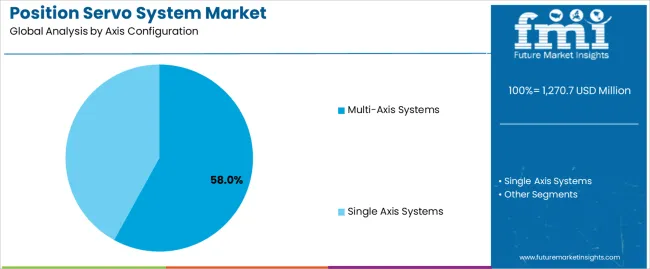
The multi-axis systems segment is projected to account for 58% of the position servo system market in 2025, reaffirming its position as the leading configuration category. Manufacturing facilities and automation integrators increasingly utilize multi-axis systems for their superior coordination capabilities, established motion synchronization, and essential functionality in complex positioning applications across multiple industrial categories. Multi-axis systems' standardized control characteristics and proven performance effectiveness directly address user requirements for reliable multi-dimensional motion and optimal automation value in advanced manufacturing applications.
This configuration segment forms the foundation of modern precision automation patterns, as it represents the format with the greatest application versatility potential and established compatibility across multiple machine platforms. Business investments in coordinated motion technology and integration standardization continue to strengthen adoption among efficiency-conscious manufacturers. With users prioritizing motion coordination and system integration, multi-axis systems align with both operational objectives and performance requirements, making them the central component of comprehensive automation strategies.
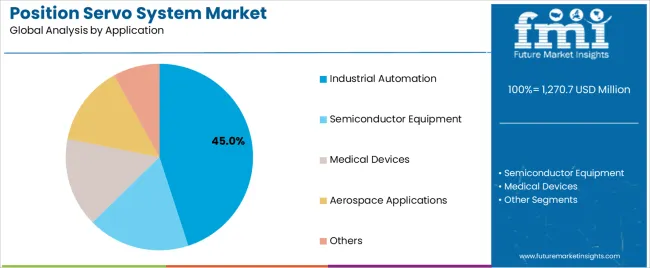
Industrial automation is projected to represent 45% of the position servo system market in 2025, underscoring its critical role as the primary application for performance-focused manufacturers seeking superior motion control benefits and enhanced production efficiency credentials. Manufacturing users and automation specialists prefer industrial automation applications for their established production patterns, proven reliability characteristics, and ability to maintain exceptional accuracy profiles while supporting versatile manufacturing operations during diverse production experiences. Positioned as essential applications for precision-conscious manufacturers, industrial automation offerings provide both operational excellence and competitive positioning advantages.
The segment is supported by continuous improvement in control algorithm technology and the widespread availability of established communication protocols that enable machine integration compliance and premium positioning at the manufacturing level. Equipment manufacturers are optimizing servo designs to support application differentiation and accessible integration strategies. As automation technology continues to advance and manufacturers seek enhanced production capabilities, industrial automation applications will continue to drive market growth while supporting operational efficiency and quality improvement strategies.
The position servo system market is advancing rapidly due to increasing manufacturing precision consciousness and growing need for automated motion control choices that emphasize superior accuracy performance outcomes across robotics segments and semiconductor applications. The position servo system market faces challenges, including competition from stepper motor alternatives, high initial investment requirements, and complexity of integration affecting adoption economics. Innovation in intelligent control algorithms and advanced feedback systems continues to influence market development and expansion patterns.
The growing adoption of position servo systems in industrial robotics and automated machinery is enabling manufacturers to develop production patterns that provide distinctive precision positioning benefits while commanding operational efficiency positioning and enhanced repeatability characteristics. Robotics applications provide superior dynamic response while allowing more sophisticated motion programming features across various automation categories. Users are increasingly recognizing the performance advantages of servo system positioning for premium motion control and precision-conscious manufacturing integration.
Modern position servo system manufacturers are incorporating advanced digital control technologies, networked communication protocols, and intelligent diagnostic systems to enhance operational capabilities, improve predictive maintenance outcomes, and meet commercial demands for connected automation solutions. These systems improve operational effectiveness while enabling new applications, including remote monitoring capabilities and predictive analytics programs. Advanced connectivity integration also allows manufacturers to support Industry 4.0 positioning and operational optimization beyond traditional motion control operations.
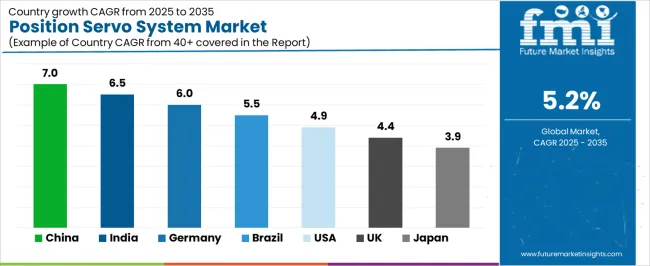
| Country | CAGR (2025-2035) |
|---|---|
| China | 7.0% |
| India | 6.5% |
| Germany | 6.0% |
| Brazil | 5.5% |
| USA | 4.9% |
| UK | 4.4% |
| Japan | 3.9% |
The position servo system market is experiencing robust growth globally, with China leading at a 7.0% CAGR through 2035, driven by the expanding manufacturing sector, growing industrial automation adoption, and increasing integration of precision control systems. India follows at 6.5%, supported by rising automation trends, expanding electronics manufacturing, and growing acceptance of advanced motion control solutions. Germany shows growth at 6.0%, emphasizing established automation capabilities and comprehensive precision engineering development. Brazil records 5.5%, focusing on industrial modernization and manufacturing expansion. The USA demonstrates 4.9% growth, prioritizing advanced manufacturing solutions and technological enhancement. The UK shows 4.4%, supported by precision engineering applications and automation advancement. Japan records 3.9%, focusing on high-precision manufacturing and technological innovation.
The report covers an in-depth analysis of 40+ countries, with top-performing countries highlighted below.
Revenue from position servo system consumption and sales in China is projected to exhibit exceptional growth with a CAGR of 7.0% through 2035, driven by the country's rapidly expanding manufacturing sector, favorable industrial policies toward automation adoption, and initiatives promoting precision manufacturing optimization across major production regions. China's position as a leading manufacturing hub and increasing focus on automated production development are creating substantial demand for high-quality position servo systems in both domestic and export markets. Major automation companies and equipment manufacturers are establishing comprehensive servo system capabilities to serve growing demand and emerging industrial opportunities.
Demand for position servo system products in India is expanding at a CAGR of 6.5%, supported by rising industrial modernization, growing electronics manufacturing requirements, and expanding automation infrastructure. The country's developing precision engineering capabilities and increasing commercial investment in advanced manufacturing are driving demand for position servo systems across both imported and domestically integrated applications. International automation companies and domestic integrators are establishing comprehensive operational networks to address growing market demand for quality servo systems and efficient motion control solutions.
Revenue from position servo system products in Germany is projected to grow at a CAGR of 6.0% through 2035, supported by the country's mature automation market, established engineering culture, and leadership in precision manufacturing standards. Germany's sophisticated industrial infrastructure and strong support for advanced manufacturing are creating steady demand for both traditional and innovative position servo system varieties. Leading automation brands and specialty integrators are establishing comprehensive operational strategies to serve both domestic markets and growing export opportunities.
Demand for position servo system products in Brazil is anticipated to expand at a CAGR of 5.5% through 2035, driven by the country's emphasis on industrial expansion, manufacturing modernization, and advanced production capabilities for equipment requiring precision motion control varieties. Brazilian manufacturers and automation integrators consistently seek commercial-grade systems that enhance operational differentiation and support industrial operations for both traditional and innovative manufacturing applications. The country's position as a South American industrial leader continues to drive innovation in specialty servo system applications and commercial integration standards.
Revenue from position servo system products in the USA is projected to grow at a CAGR of 4.9% through 2035, supported by the country's emphasis on advanced manufacturing, automation standards, and sophisticated technology integration requiring efficient motion control solutions. American businesses and equipment manufacturers prioritize system performance and integration capabilities, making position servo systems essential components for both traditional and modern automation applications. The country's comprehensive technology leadership and advancing manufacturing patterns support continued market expansion.
Demand for position servo system products in the UK is expanding at a CAGR of 4.4% through 2035, supported by established precision engineering traditions, advanced manufacturing capabilities, and growing automation adoption across industrial sectors. British manufacturers and automation specialists prioritize system reliability and performance characteristics, driving steady demand for quality position servo systems in both traditional and emerging applications. The country's focus on engineering excellence and manufacturing innovation supports continued market development.
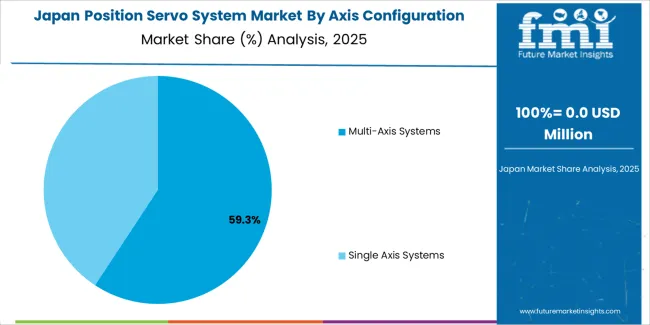
Revenue from position servo system products in Japan is growing at a CAGR of 3.9% through 2035, driven by the country's leadership in precision manufacturing, robotics innovation, and sophisticated automation technologies requiring advanced motion control solutions. Japanese manufacturers and technology companies consistently seek high-performance systems that enhance operational precision and support manufacturing excellence for both traditional and cutting-edge industrial applications. The country's position as an Asian technology leader continues to drive innovation in advanced servo system applications and precision integration standards.
The Europe position servo system market is projected to grow from USD 381.2 million in 2025 to USD 632.9 million by 2035, recording a CAGR of 5.2% over the forecast period. Germany leads the region with a 42.0% share in 2025, moderating slightly to 41.5% by 2035, supported by its strong industrial automation base and demand for premium, precision-engineered motion control products. The United Kingdom follows with 18.5% in 2025, easing to 18.0% by 2035, driven by advanced manufacturing sectors and emphasis on automation efficiency standards. France accounts for 15.0% in 2025, rising to 15.5% by 2035, reflecting steady adoption of industrial automation solutions and precision manufacturing optimization. Italy holds 12.0% in 2025, expanding to 12.5% by 2035 as machinery manufacturing and specialty automation applications grow. Spain contributes 6.5% in 2025, growing to 7.0% by 2035, supported by expanding industrial sector and automated production handling. The Nordic countries rise from 4.0% in 2025 to 4.2% by 2035 on the back of strong automation adoption and advanced manufacturing technologies. BENELUX remains at 2.0% share across both 2025 and 2035, reflecting mature, efficiency-focused industrial markets.
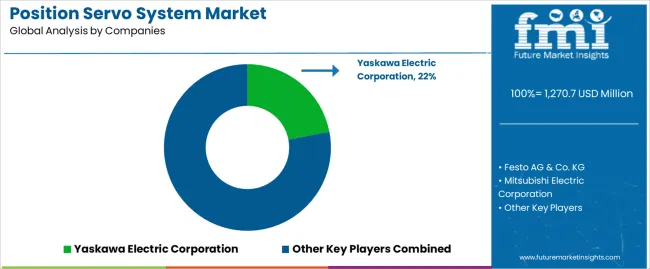
The position servo system market is characterized by competition among established automation manufacturers, specialized motion control producers, and integrated technology solution companies. Companies are investing in advanced control algorithms, precision feedback technologies, product innovation capabilities, and comprehensive distribution networks to deliver consistent, high-quality, and reliable position servo system solutions. Innovation in digital control enhancement, connectivity integration methods, and application-specific product development is central to strengthening market position and customer satisfaction.
Yaskawa Electric Corporation leads the position servo system market with a strong focus on motion control innovation and comprehensive servo system solutions, offering commercial automation systems with emphasis on manufacturing excellence and technological heritage. Festo AG & Co. KG provides specialized automation capabilities with a focus on global market applications and pneumatic integration networks. Mitsubishi Electric Corporation delivers integrated motion control solutions with a focus on industrial positioning and operational efficiency. Siemens AG specializes in comprehensive automation systems with an emphasis on commercial applications. ADVANCED Motion Controls focuses on comprehensive servo drive solutions with advanced control capabilities and premium positioning capabilities.
The success of position servo systems in meeting commercial automation demands, precision-driven manufacturing requirements, and performance integration will not only enhance operational efficiency outcomes but also strengthen global industrial automation capabilities. It will consolidate emerging regions' positions as hubs for efficient manufacturing automation and align advanced economies with commercial motion control systems. This calls for a concerted effort by all stakeholders -- governments, industry bodies, manufacturers, distributors, and investors. Each can be a crucial enabler in preparing the position servo system market for its next phase of growth.
How Governments Could Spur Local Production and Adoption?
How Industry Bodies Could Support Market Development?
How Distributors and Industrial Equipment Industry Players Could Strengthen the Ecosystem?
How Manufacturers Could Navigate the Shift?
| Items | Values |
|---|---|
| Quantitative Units (2025) | USD 1,270.7 million |
| Axis Configuration | Single-axis Systems, Multi-axis Systems, Coordinated Motion Systems |
| Application | Industrial Automation, Semiconductor Equipment, Medical Devices, Aerospace Applications, Others |
| Control Type | Analog Control, Digital Control, Networked Control Systems |
| Feedback Mechanism | Encoder Feedback, Resolver Feedback, Absolute Position Feedback |
| Regions Covered | North America, Europe, Asia Pacific, Latin America, Middle East & Africa, Other Regions |
| Countries Covered | China, India, Germany, Brazil, United States, United Kingdom, Japan, and 40+ countries |
| Key Companies Profiled | Yaskawa Electric Corporation, Festo AG & Co. KG, Mitsubishi Electric Corporation, Siemens AG, ADVANCED Motion Controls, and other leading servo system companies |
| Additional Attributes | Dollar sales by axis configuration, application, control type, feedback mechanism, and region; regional demand trends, competitive landscape, technological advancements in control algorithms, digital integration initiatives, connectivity enhancement programs, and premium product development strategies |
The global position servo system market is estimated to be valued at USD 1,270.7 million in 2025.
The market size for the position servo system market is projected to reach USD 2,109.7 million by 2035.
The position servo system market is expected to grow at a 5.2% CAGR between 2025 and 2035.
The key product types in position servo system market are multi-axis systems and single axis systems.
In terms of application, industrial automation segment to command 45.0% share in the position servo system market in 2025.






Full Research Suite comprises of:
Market outlook & trends analysis
Interviews & case studies
Strategic recommendations
Vendor profiles & capabilities analysis
5-year forecasts
8 regions and 60+ country-level data splits
Market segment data splits
12 months of continuous data updates
DELIVERED AS:
PDF EXCEL ONLINE
Repositionable Labels Market Size and Share Forecast Outlook 2025 to 2035
Market Share Breakdown of Repositionable Labels Manufacturers
Repositioning and Offloading Market – Trends & Forecast 2024 to 2034
Repositioning & Offloading Devices Market – Demand & Forecast 2024 to 2034
Predisposition Biomarkers Market Size and Share Forecast Outlook 2025 to 2035
X-Ray Positioning Devices Market Size and Share Forecast Outlook 2025 to 2035
Valve Positioner Market Growth – Trends & Forecast (2024-2034)
Spine Positioning Devices Market
Multi-Position Cylinder Market
Infant Positioning Aids Market Size and Share Forecast Outlook 2025 to 2035
Global Positioning Systems Market Size and Share Forecast Outlook 2025 to 2035
Patient Positioning Equipment Market Size and Share Forecast Outlook 2025 to 2035
Body Composition Monitor and Scale Market Size and Share Forecast Outlook 2025 to 2035
Dynamic Positioning System Market Size and Share Forecast Outlook 2025 to 2035
Patient Positioning System Analysis by Product Type and by End User through 2035
Capacitive Position Sensors Market Size and Share Forecast Outlook 2025 to 2035
Crankshaft Position Sensor Market Growth – Trends & Forecast 2025 to 2035
Automotive Position Sensor Market
Seating And Positioning Belts Market Size and Share Forecast Outlook 2025 to 2035
IT Asset Disposition Market Growth – Trends & Forecast 2024-2034

Thank you!
You will receive an email from our Business Development Manager. Please be sure to check your SPAM/JUNK folder too.
Chat With
MaRIA